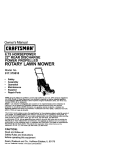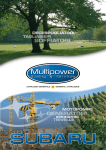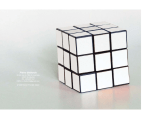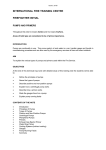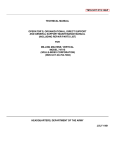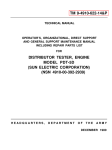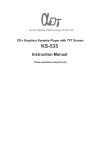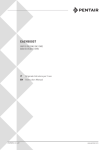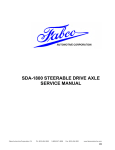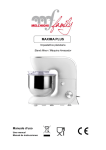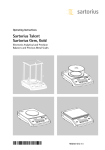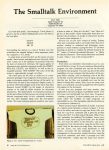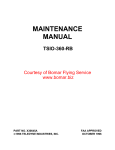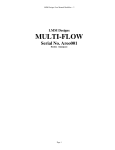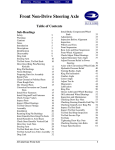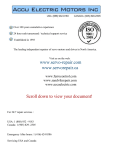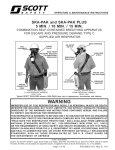Download rockfordarmy16shaper..
Transcript
TM 9-3418-201-14&P TECHNICAL MANUAL OPERATOR’S, ORGANIZATIONAL, DIRECT SUPPORT, AND GENERAL SUPPORT MAINTENANCE MANUAL INCLUDING REPAIR PARTS LIST FOR SHAPER, METAL CUTTING HORIZONTAL NSN 3418-00-808-0475 (ROCKFORD MACHINE TOOL CO.) HEADQUARTERS, DEPARTMENT OF THE ARMY JULY 1981 TM 9-3418-201- 141&P WARNING Dirt or dirty oil in this machine will cause serious injury and expensive repairs. Use only clean vessels for handling oil, and pour all oil through strainer provided. WARNING Oil level must be maintained. Entire system should be drained and refilled with fresh oil often enough to maintain the lubricating value of the oil. All oils should have anti-rust and oxidation additives. WARNING Before breaking any circuit connections, be certain the electrical power is off and the system is relieved of trapped pressure. TM 9-3418-201-14&P Technical Manual No. 9-3418-201-14&P } HEADQUARTERS DEPARTMENT OF THE ARMY Washington, DC, 17 July 1981 OPERATOR, ORGANIZATIONAL, DIRECT SUPPORT AND GENERAL SUPPORT MAINTENANCE MANUAL INCLUDING REPAIR PARTS LIST FOR SHAPER, METAL CUTTING, HORIZONTAL (NSN 3418-00-808-0475) REPORTING OF ERRORS You can help improve this manual. If you find any mistakes or if you know of a way to improve the procedures, please let us know. Mail your letter, DA Form 2028 (Recommended Changes to Publications and Blank Forms), or DA Form 2028-2, located in the back of this manual direct to: Commander, US Army Armament Materiel Readiness Command, ATTN: DRSAR-MAS, Rock Island, IL 61299. A reply will be furnished direct to you. Manufactured by: Rockford Machine Tool Co. 2500 Kishwaukee Street Rockford, IL 61101 Procured under Contract No. DAAA09-76-C-6910 This technical manual is an authentication of the manufacturers’ commercial literature and does not conform with the format and content specified in AR 310-3, Military Publications. This technical manual does, however, contain available information that is essential to the operation and maintenance of the equipment. i TM 9-3418-201-14&P TABLE OF CONTENTS Page Receiving and Handling...................................................................................................................... Cleaning ............................................................................................................................................. Installation .......................................................................................................................................... Floor Plan ........................................................................................................................................... Electrical Connections and Wiring...................................................................................................... Hydraulic Oils ..................................................................................................................................... Wiring Diagram .................................................................................................................................. Filling Oil Reservoir. ........................................................................................................................... Starting the Machine........................................................................................................................... Operating the Machine. ...................................................................................................................... Universal Table................................................................................................................................... Power Feed. ....................................................................................................................................... Cutting Tools.. .................................................................................................................................... Hydraulic Circuit. ................................................................................................................................ Reversing Valve Chokes.. .................................................................................................................. Motor and Pump. ................................................................................................................................ Pump Maintenance Instructions . ....................................................................................................... Pump Service Parts Information ........................................................................................................ Flow Control and Overload Relief Valves .......................................................................................... Valve Maintenance............................................................................................................................. Valve Parts Drawing........................................................................................................................... Specifications. .................................................................................................................................... Maintenance - Lubrication. ................................................................................................................. Lubrication Chart. ............................................................................................................................... Parts List............................................................................................................................................. 1 2 2 3 4 4 5 6 6 8, 9 10 11 11 12, 13 14, 15 15 16-23 24-29 30 31, 32 33-36 37 38 39 40- 65 LIST OF ILLUSTRATIONS Figure Title 1 2 3 4 5 6 7 8 9 10 11 12 13 14 Page Right Side with Plain Table.................................................................................................... Left Side with Universal Table............................................................................................... Tool Head.............................................................................................................................. Power Downfeed - Optional................................................................................................... Main Crossrail Unit.. .............................................................................................................. Crossrail Gear Box. ............................................................................................................... Crossrail Feed and Rapid Traverse. ..................................................................................... Crossrail Vertical Feed.. ........................................................................................................ Universal Table - Optional..................................................................................................... Pilot Valve and Trip Dogs...................................................................................................... Combination Valve and Controls........................................................................................... Hydraulic Valves.................................................................................................................... Ram Cylinder......................................................................................................................... Safety Crank.......................................................................................................................... ii 41 42 44 46 48 50 52 54 56 58 60 62 64 65 TM 9-3418-201-14 & P INSTRUCTIONS FOR REQUISITIONING PARTS NOT IDENTIFIED BY NSN When requisitioning parts not identified by National Stock Number, it is mandatory that the following information be furnished the supply officer. 1 - Manufacturer’s Federal Supply Code Number - 51292 2 - Manufacturer’s Part Number exactly as listed herein. 3 - Nomenclature exactly as listed herein, including dimensions, if necessary. 4 - Manufacturer’s Model Number - Model 5 - Manufacturer’s Serial Number (End Item) 6 - Any other information such as Type, Frame Number, and Electrical Characteristics, if applicable. 7 - If DD Form 1348 is used, fill in all blocks except 4, 5, 6, and Remarks field in accordance with AR 725-50. Complete Form as Follows: (a) In blocks 4, 5, 6, list manufacturer’s Federal Supply Code Number - 51292 manufacturer’s Part Number for the repair part. (b) Complete Remarks field as follows: Noun: (nomenclature of repair part) For: NSN: 3418-00-808-0475 Manufacturer: Rockford Machine Tool Co. Model: Serial: (of end item) Any other pertinent information such as Frame Number, Type, Dimensions, etc. iii followed by a colon and TM 9-3418-201-14 & P SERVICE MANUAL for the INSTALLATION OPERATION and MAINTENANCE of the HORIZONTAL, METAL CUTTING Hy- Draulic SHAPER 16 inch Series 15 TM 9-3418-201-14 & P RECEIVING Before accepting the machine ,a preliminary examination should be made for any possible damage in transit. If there is evidence of such damage a notation to that effect should be made on the receipt and the machine received subject to thorough inspection. When the extent of the damage has been determined, your reports should be filed. HANDLING The best method of handling the shaper is by means of a crane with adequate capacity. By removing the top boards of the crate and the water proof covering, a rope or sling may be attached as shown. The sling should be crossed over the crane hook to prevent slipping. A sling to carry a load of at least 10,000 pounds should be used. If no crane is available rollers must be used. In moving the machine on rollers leave the skids attached until it has reached the place of installation. Always be careful that the ends of the skids do not drop off a roller as damage to the machine may result. 1 TM 9-3418-201-14 & P CLEANING Before shipment, all unpainted surfaces were coated with a rust preventive compound. This may be removed by wiping with rags saturated with a nonflammable cleaning fluid. Clean only by wiping and brushing. Do not use compressed air as this tends only to force dirt and grit into the working parts. After the slushing compound has been removed, wipe all finished surfaces with a cloth moistened with lubricating oil. Do not move any of the controls or moving parts until the machine has been thoroughly cleaned and lubricated. INSTALLATION The first consideration in maintaining the accuracy of any machine tool is to see that it is supported by a rigid foundation. For a machine of this size a concrete floor furnishes sufficient foundation. Anchor bolts should be embedded in the concrete. Holes for six anchor bolts are provided in the base plate, one pair near the front end, one pair at the front corner of the column, and one pair at the rear corner. Level the machine by using steel wedges ,under the base plate near the anchor bolts at the four corners of the column, leaving the front end of the base plate free. For crosswise leveling use the finished top of the cross rail. For lengthwise leveling use the finished top of the column along the ram ways. Use a precision machine level. A carpenter’s or mason’s level is not sufficiently accurate for this purpose. When the machine has been leveled from these four points, tighten the nuts on those four anchor bolts. Then, with the leveling screws at the front of the base plate make adjustment until the plate on which the outer table support slides is exactly parallel to the cross rail and tighten the screws on the two front anchor bolts. With a rich mixture of portland cement and clean building sand and enough water to make a thick mixture (grout) fill the space between the base plate and the floor using sufficient grout around the outside to embed the base plate to a depth of one inch or more. Allow sufficient time for the grout to harden before starting the machine. On a machine having a plain table the entire base plate may be embedded in grout as shown. The universal table requires clearance so that the outer table support may be lowered to the bottom surface of the base plate. Therefore the space across the front end of the base plate should be filled with grout only up to the bottom surface of the plate. The floor plan on the following page is typical of the area and shape of the space required. For actual installation use only the certified print which is mailed prior to shipment of the machine. If a concrete foundation is to be built, consideration should be given as to whether or not conduit for electric wiring is to be embedded. The floor plan shows the location of the entrance of electric wires. 2 TM 9-3418-201-14&P 3 TM 9-3418-201-14&P ELECTRICAL CONNECTIONS AND WIRING The electrical system of the hydraulic shapers consists of a motor for driving the main hydraulic pump, a motor to power the table traverse and rail elevation, together with suitable push button station and magnetic switches for starting the motors. A wiring diagram shows the wiring which is considered standard; however, for your individual machine use only the wiring diagram furnished for that machine. When connecting the line wires to the control panel, jog the motors slightly to see that they run in the direction indicated by the arrows attached to them. Remember that as yet the hydraulic system has no oil in it, therefore any more than a slight jogging of the motor will be courting injury to the pump. HYDRAULIC OILS The oil used in the hydraulic system must be of a type proven suitable for the purpose. It should not foam nor emulsify under constant agitation, should have high resistance to oxidation, and must be free from lint, chips, water, sludge, and all other foreign substances. In addition it should meet the following specifications: Viscosity Index ...........................73 Min. Viscosity .....................................300 S. S. U. at 100° F. Pour Point...................................10 F. Max. Flash...........................................355° F. Min. Fire .............................................405° F. Min. 4 TM 9-3418-201-14&P 5 TM 9-3418201-14 & P FILLING OIL RESERVOIR For filling the oil reservoir it is recommended that a 30 gallon drum of an approved oil be obtained. The oil may be poured through the rectangular opening in the cover plate on the left side of the machine column. Pour in sufficient oil to bring the level up to the mark on the gauge at the lower rear corner of the column. This will be sufficient until after the machine has been started. At that time more oil must be added since a consider- able quantity will be drawn from the reservoir to fill the pump, valves, piping and cylinder. Use only clean new oil and clean containers for handling it. STARTING THE MACHINE Before starting the machine, lubricate it thoroughly as directed in the section LUBRICATION. When ready to start, set the ram selector lever in the STOP position and the table selector and clutch engaging lever in the OFF positions. The stroke control knobs should be well toward the ends of their slot to give the ram a long stroke. Set the flow control lever about midway across its dial. Start the main driving motor by pressing the START button of the control station. Allow the motor to run idle for a minute or two to prime the pump and build up pressure which starts the oil flowing through the overload relief valve. Shift the ram start-stop lever to the LOW position to set the ram into motion. If at first the ram action is unsteady, it is due to the air in the system. If allowed to run for a few minutes, the air will be worked out and the ram will have a steady motion with smooth reversals. After the first few strokes observe the ram ways to see that a film of oil is covering their surfaces. If the ram ways are dry, stop the machine immediately and investigate as instructed in the section LUBRICATION. The machine has now been prepared for operation and therefore the motor should be stopped by pressing the STOP button and returning all control levers, to their OFF or STOP positions. When the oil has come to rest, check the level in the oil gage and add whatever is necessary to again bring it up to the correct height. It may be one half inch above or below the mark on the gage without danger. 6 TM 9-3418-201-14&P 7 TM 9-3418--01-14 & P OPERATING THE MACHINE All control levers and adjustments are grouped within a small space, making them convenient to the operator’s reach. Identification numbers of the various controls shown in illustration on opposite page are as follows: 1. The ball crank on the top of the vertical feed screw is for manually feeding the tool head up or down. Directly below the crank is a graduated collar which shows the amount of travel. Each graduation of the dial represents a movement of one thousandth (0.001)inch of the tool head. When so ordered a power feeding mechanism is furnished for the tool head. A description of the power vertical feed is given on page 15. 2. This knob and plunger must be pulled outward to allow lever 3 to be shifted to the high speed range position. 3. This lever starts, stops, and selects the speed of the ram. There are two ranges of speed, high and low. Within each range lever 6 provides infinitely variable speed changes. The dial on lever 3 is marked to show the setting for the various functions. 4. The length and position of the ram stroke is determined by the setting of these knobs. On the inside of the ram and attached to these knobs are the reversing cams which actuate the pilot valve for reversing the ram stroke. The knob at the rear reverses the ram at the end of the cutting stroke while the one at the front reverses on the return stroke. 5. Reversal of the direction of ram stroke at any point during either cutting or return is accomplished by means of this lever. To become acquainted with the advantages of this lever, start the ram into motion with a long, slow stroke. When the ram has reached a point about midway in the cutting stroke shift this lever toward the rear and note that the ram immediately reverses. Shifting toward the front has the same effect during the return stroke. As an example of the value of this feature, suppose that the feed had been set to an amount greater than the power of the machine could accommodate and the ram stalled in the cut. By simply shifting this lever the tool is backed out to permit adjustment of the difficulty. Other advantages will be discovered as experience is gained in the operation of the machine. 6. The valve operated by this lever varies the quantity of oil delivered to the ram cylinder and thereby governs the ram speed. The valve operates in the same manner in both the high speed and low speed ranges which are selected by lever 3. Shifting the lever toward the front decreases the ram speed; toward the rear increases it. By using levers 3 and 6 in conjunction with each other any speed, from the lowest in the low speed range to the highest in the high speed range, may be obtained. When operating in the high speed range, the flow of oil to the cylinder must not be reduced below the low speed range. 7. The amount of cross or vertical feed to the table is regulated by this handwheel. Screwing it down decreases the feed, up, increases it. The selection as to vertical or cross feed is made by the setting of lever 8. 8 and 9. These two levers are used in conjunction with each other. Lever 9 selects the setting for either vertical or horizontal movement of the table and after it has been set lever 8 selects the direction of motion for that setting. 8 TM 9-3418-201-14 & P Shifting lever 9 to the left engages the vertical travel and then lever 8 selects the upward or downward travel of the table and cross rail. Shifting lever 8 to the left or FORWARD position raises the rail, to the right or REVERSE lowers the rail. If lever 9 is set to the right or CROSS position and--lever 8 to the FORWARD position the table will travel toward the rear or away from the operator. Shifting lever 8 to the REVERSE position causes the table to move toward the operator. These settings apply to both the feeding and power traverse mechanisms. When using the power traverse be sure that the traverse motor is STOPPED before shifting the levers. When using the hand safety crank set both levers 9 and 8 to the OFF position. 10. This knob must be pulled up to shift lever for vertical travel of rail. 11. When the cross rail is to be raised or lowered by hand, the safety crank furnished is to be used on this shaft. When using the hand crank lever 9 must be in the OFF position and the upper plates which clamp the cross rail to the column must be released. The graduated collar on the shaft indicates the amount of movement of the rail. Each graduation indicates a movement of one thousandth (0.001) inch. A setscrew in the knurled rim may be used for locking the dial at any setting. 12. This is the screw for moving the table along the cross rail. The squared end is to receive the safety crank for hand operation. When using the crank lever 9 must be in the OFF position. The graduated collar on the screw indicates the amount of movement of the table. Each graduation indicates a movement of one thousandth (0.001ol) inch. A setscrew in the knurled rim may be used to lock the dial at any setting. The screw projects through the opposite end of the cross rail permitting the use of the crank at either end. Directly behind the feed cylinder is an electric motor to supply power for the rapid traverse of the table either vertically or horizontally. The motor is started and stopped by using the TRAVERSE button on the control station. The motor will run only as long as the button is held in contact. The direction of both feed and traverse is determined by the setting of levers 8 and 9. 13. Before lowering the table be sure to loosen the clamp nuts on the outboard support, and the two clamp nuts behind the rail. After the table has been moved to the desired position these nuts should be tightened in order to provide a rigid support for the table during the planing operation. 14. At the rear of the cross rail and holding it to the column are four plates, two on either side. The lower plates are scraped to a sliding fit and need no attention during the operation of the machine. The top plates are so made that the rail may be clamped to the column by tightening the nuts which hold the plates in position. When raising or lowering the rail the clamp plates nust be loosened. When shaping is to be done with the rail in a stationary position the clamp plates should be tightened to provide greater rigidity to the work table. 9 TM 9-3418-201-14 & P. UNIVERSAL TABLE The hydraulic shaper is furnished with a plain table as standard equipment, however, a universal table is available as alternate equipment when so ordered. The universal table has a tilting top which is adjustable 15 degrees in either direction. To tilt the top loosen the clamping nuts(l4)on both sides of the table. Unscrew and remove locating block(18);then, with the hand crank on worm shaft(19),tilt the table to the desired position reading the angle on etched plate (22). Tighten clamping nuts (l4)before doing any cutting. The table also revolves on its trunnion through a complete revolution of 360 degrees. To revolve the table loosen clamp nuts(15)and unscrew and remove tapered dowel pin (21). With a crank on worm shaft(16 or 20)the table may be rotated to the desired angle which is read on the graduations at (l17).Tighten clamp nuts (15)before doing any cutting. When the table is returned to the upright position dowel pin(21) may be replaced thereby assuring the exact positioning of the table. If the table is rotated 90 degrees to the left it will present a large flat working surface with T slots similar to a plain table. When raising or lowering the table do not forget to loosen the clamp nuts on the outboard table support. 10 TM 9-3418-201-14 & P TOOL HEAD POWER FEED The attachment providing power vertical feed to the tool head is not standard equipment but is applied to machines when so ordered. The attachment consists of an adjustable cam or shoe attached to the column, and an arm and roller riding over the cam, and connected to the vertical feed screw of the tool head The direction of feed, up or down, is selected by a lever mounted on the top of the ram. The amount of feed is regulated by a screw with a knurled knob mounted on the side of the ram. Turning the screw downward decreases the amount of feed; upward increases it. The amount of feed is indicated by the graduated collar at the top of the vertical feed screw. The actuating cam on the top of the column is adjustable forward and backward and should be set so that the feeding action takes place just before the end of the return stroke of the ram. CUTTING TOOLS The conventional types of cutting tools are suitable for use on this machine. Plain forged tools may be used or the inserted bit type of tool holder sets may be obtained from any of several manufacturers of such articles. If formed tools are to be used they, of course, must be made to suit the job in hand. 11 TM 9-3418-201-14 & P HYDRAULIC CIRCUIT The diagram below shows the general principle on which the circuit operates. It does not show the details of piping on the machine. Before shipment of the machine adjustments were made to assure the correct functioning of all parts. Further adjustments should be unnecessary and may be detrimental to the smooth operation of the machine, Illustrations on the following pages show the actual piping of the circuit. 12 TM 9-3418-201-14&P 13 TM 9-3418-201-14&P REVERSING VALVE CHOKES On the main valve body are placed four choke plugs, two at each end, for the purpose of adjusting the ram reversals at each end of its stroke. By means of these chokes the rate of deceleration at the end of the stroke may be controlled. Likewise the rate of acceleration at the beginning of the stroke may be controlled. These chokes are adjusted by experts at our factory to give the most suitable ram action under the conditions existing here. No further adjustment should be necessary and the chokes should not be tampered with. However, in rare cases, the conditions under which the machine must operate in a customer’s plant may require a slight readjustment of the chokes. If such a case arises no one except a thoroughly experienced mechanic should attempt to change the setting. The following is offered in explanation of the functioning of the choke plugs. They operate on the principle of a needle valve for governing the rate at which oil may be discharged from the space at the ends of the reversing valve spool, and therefore the speed at which the valve spool travels during the shifting action. If the chokes are open too far the ram will reverse with a shock or bump at the end of the stroke; if closed too much the ram will be sluggish in its action. Chokes 3 and 4 control the reversal of the ram at the end of the cutting stroke and beginning of the return stroke. Chokes 1 and 2 control the reversal at the end of the reverse stroke and beginning of the cutting stroke. When the correct adjustment has been made the ram will have a snappy action but still without shock. 14 TM 9-3418-201-14&P It was stated previously that no one except a thoroughly experienced mechanic should be allowed to make adjustments. This is for the reason that no exact formula can be given for setting the chokes. It is more a matter of gaining experience in the results obtained with different settings. However, it can be explained that screwing the chokes inward will slow up the ram action, while opening them will produce sharper reversals. Adjustments should be made slowly and carefully so that the result of each slight turn may be observed. Care must be taken to see that chokes 2 and 3 are not screwed in too far as this would cause damage to the valve spool and the choke. The chokes become accessible by removing the square door from the left side of the column. Before starting to make adjustments the feed cylinder should be entirely closed off either by closing the valve at the bottom of the cylinder or by screwing the feed adjusting screw down so that the feed piston has no movement. For the first adjustment of the chokes the ram should be set for the shortest possible stroke and adjustments made for the low and high ram speeds. Then set the reversing dogs for a long ram stroke and observe that it may be necessary to open the chokes slightly to get the best action. The ideal setting is to strike a balance between the short stroke at high speed and the long stroke at low speed. MOTOR AND PUMP The Hy-Draulic shaper is powered by an electric motor directly connected to the hydraulic pump by a flexible type . coupling. On the 16”, 20” and 24” standard a 71/2 H. P motor is used. The 24” Heavy and 28” carry a 10 H. P. motor. On direct current or 60 cycle alternating current the motor runs at 1200 R.P.M., on 50 cycle at 1000 R.P.M., and on 25 cycle at 750 R.P.M. On the 16', 20' and 24' standard the pumps are as follows: 1200 R. P. M. ...........................................................................Model V-135-20 1000 R. P. M. .............................................................................. .” V-135-U-20 750 R. P. M. .................................................................................." V-135-X-20 On the 24' Heavy and 28' the following pumps are used: 1200 R. P. M. ...........................................................................Model V-135-X-20 1000 R, P. M. ................................................................................" V-145-20 750 R. P. M.. ................................................................................." V-145-20 Installation and maintenance information on all pumps is given in Bulletin 1-133744 and I-3100S. Parts are listed on parts drawing I-3102S. Both of these publications are included in this book. Sequence valve pressure is set at 250 lbs. with pump running and ram stopped. Main pressure is set at 1000 lbs. with ram stalled in cut or at the end of stroke. 15 TM 9-3418-201-14&P SERVICE AND MAINTENANCE INSTRUCTIONS SINGLE STAGE SINGLE AND DOUBLE VANE PUMPS OPERATING CHARACTERISTICS TYPE ..................................Balanced Vane, Fixed Delivery SERIES .................................Single and Double, Single Stage OPERATING PRESSURE. ...... See Performance Data INPUT SPEED, RPM................ See Performance Data OPERATING FLUID ..... 150 S.S. U. at 100°F MOUNTNG ...........Face, Foot, Flange, Electric Motor End Bell CONNECTIONS ...... Pipe Thread Body Ports or Flanges Performance data is based on input speed at 1200 rpm , pumping petroleum base fluid at 1200 F. Minimum recommended drive speed for all series is 600 rpm,. Characteristics at other drive speeds are approximately proportional to rpm . For performance data when using! other than petroleum base fluids, see applicable Installation drawing , shown on page 25. 16 TM 9-3418-201-14&P DOUBLE PUMP SERIES - SINGLE STAGE Small Series Combination 17 TM 9-3418-201-14&P Large and Small Series Combination DESCRIPTION This manual contains service and maintenance information for single and double pumps. These hydraulically balanced cartridge type vane pumps are used to provide a constant supply of hydraulic fluid under pressure and are produced in three basic housing sizes: small, intermediate and large. Cartridges of different displacement may be used interchangeably in each series. These pumps can be used as single units or two maybe assembled on a common drive shaft (double pump) providing an almost infinite number of combinations. Figure 1 illustrates a cross sectional view of a flange mounting, small and intermediate series combination double pump, assembled for LH rotation. Figure 1 18 TM 9-3418-201-14&P OPERATION Operation: Pumping is performed by cartridges good quality, high temperature, bearing grease. consisting of a ring,’ rotor, two bushings, twelve vanes CAUTION and a locating pin or screws (see figure 2). The splined Over-lubrication can damage the shaft seal. pump shaft rotates driving a slotted rotor. Vanes within the rotor slots are thrown out by centrifugal force and Routine Inspection and Maintenance: held out by system pressure to follow a double lobed cam ring. Movement of the vanes in and out as they a. Make certain all hydraulic connections are tight follow the cam causes the chambers between them to to prevent fluid leakage or entry of air into the system. increase in size and pick up fluid from the reservoir as the vanes cross the inlet porting. Chamber size b. Check fluid level in the reservoir to assure an decreases when the vanes cross the outlet porting adequate supply to the pump intake. When adding fluid, forcing fluid out into the system. always pour it through a 200 mesh or finer screen. The size of the cartridge ring determines the pump displacement. Ring change alters delivery. However, the 11 gpm ring in the small series and the 36 gpm ring in the intermediate series are used with wide vanes and rotor so conversions to these capacities require additional change of rotor, vanes and head. c. Inspect the filter element and replace if dirty. d. Inspect the fluid for contamination. If contaminated, drain the system and thoroughly clean the reservoir. Change the filters and flush the complete system with clean fluid. Again drain the system and refill with new fluid. Lubrication: None is required for current design models. Older designs require lubrication of the front shaft e. Check the reservoir air breather and replace if bearing. A grease fitting is provided on top the pump dirty. body. (Some of the larger pumps also incorporate a grease relief fitting on the bottom of the body.) It is recommended that these fittings be lubricated sparingly (approximately one tablespoonful every six months) with a low pressure gun using a OVERHAUL Complete overhaul may be accomplished by means of Remove light scores by lapping; replace if heavily cartridge and gasket kits. scored. Stone new parts lightly to remove burrs. d. Bearings for cracked or pitted races or pitted Disassembly may be accomplished in the order shown balls. Replace if defective. in the illustration (see figure 3 or 4). e. Shaft for wear at seal lip journal. Replace if WARNING scored. Before breaking any circuit connections, f. Replace shaft seal, 0 ring and head packing at be certain the electrical power is off and each teardown. the system is relieved of trapped pressure. Reassembly: Assemble parts in reverse order of Prepare a clean, lint-free surface on which to lay internal disassembly, noting the following: parts of the pump. Thoroughly clean areas adjacent to a. Assemble seals with spring toward inside of the the components being removed to minimize possibility of pump. dirt entering the system. Cap or cover all exposed ports b. Coat all parts with compatible fluid and lightly and openings into the system. lubricate the lip of the shaft seal to prevent damage during installation. Inspect and replace as follows: c. Install bearing and snap ring on shaft end and place in the body. a. Vanes, for wear and sticking in rotor slots. d. Spring in the shaft seal must be toward the shaft Vanes must move in slots from their own weight when bearing. dry. Replace if defective. Stone new vanes lightly on an e. Install cartridge parts so arrows on the parts are India stone to remove sharp edges. pointed for intended rotation as viewed from the shaft b. Ring, for scored or cross-grooved cam face. end. Replace if grooved or scored. f. Assemble the pin so its small diameter end fits into the body for RH rotation (large end in body for LH Faces of rotor and bushings for wear and scoring. rotation). See installation page 23. 19 TM 9-3418-201-14&P Figure 2 CARTRIDGE ASSEMBLY AND INSTALLATION Figure 2 illustrates a typical cartridge assembly and HEAD SCREW ADJUSTMENT installation, when viewed from the head end. The cartridge assembly procedure is the same for both single Some pump cover heads and intermediate heads and double pumps, depending on the direction of shaft (double pumps) are provided with two small holes to rotation. match the two diameters of the locating pin. Install the head so the pin fits the hole size to prevent the pin from The stepped diameter locating pin prevents improper bending or shearing when the pump is put into operation. assembly of the cartridge. However, caution must be exercised to install the cartridge properly for the direction Pull the head down gradually, alternately tightening the of rotation desired. screws 1800 from each other until the head seats evenly on the bushing. Turn the shaft by hand during the process until a light, smooth snugness is felt through a The large series pump cartridges have a locating screw complete revolution. Do not over-tighten the screws, and a retaining screw in lieu of the locating pin used in causing the shaft to bind. the small and intermediate series. Before starting these pumps, check for freedom of movement of the internal parts by turning the shaft by hand. Never start a pump which shows evidence of binding. NOTE The direction of rotation (RH or LH) is always determined by viewing the pump from the shaft end. CAUTION A new or overhauled pump must be started under load on the first run. This will create a back pressure to assure adequate internal lubrication. After a pump is broken in, it can be started under no-load conditions. INSTALLATION Right hand rotation: Insert the small end of the locating pin into the small hole in the pump body at a 3 o’ clock position. Left hand rotation: Insert the large end of the locating pin into the large hole in the pump body at a 6 o’clock position. Start the pump by jogging the drive motor a few times to be sure the pump is primed. 20 TM 9-3418-201-14&P If the pump is new or has been overhauled, be certain it loading of’ the drive shaft. is properly installed. Check the direction of shaft rotation Pump life will be shortened by operation beyond and alignment of the shaft with the drive motor. Since it maximum pressure and speed ratings. Since these units is difficult to achieve perfect shaft alignment, a flexible are positive displacement, a relief valve must be used to coupling must be used. limit maximum system pressure to recommended limits. Exercise care with pumps driven by belts, chain drives, spur gears, etc. to prevent excessive side TROUBLESHOOTING CHART TROUBLE PROBABLE CAUSE REMEDY PUMP NOT DELIVERING FLUID Pump driven in wrong direction of Must be reversed immediately to rotation. prevent seizure. Check direction of drive rotation against proper pump rotation as indicated by arrow on body. Pump drive shaft broken or shaft Remove pump from accessory key sheared (direct drive). mounting pad and determine damage to pump cartridge. Replace needed parts. Fluid intake pipe in reservoir Drain complete system. Add new blocked or oil viscosity too heavy fluid of proper viscosity. Filter to pick up prime. Viscosity should the new fluid as recommended. not exceed 4000 S. S.U. Checkall filters for dirt and sludge. Air leaks at intake. Check intake connection for air leak. Tighten securely. Pump not priming. Loosen connection in outlet line. Bleed-off air until fluid flows. Oil level too low. The fluid level must be above intake opening in intake pipe. Check minimum drive speed which may be too slow to prime the pumps. Vane or vanes stuck in rotor Inspect rotor slots for wedged chips slots. or foreign particles and replace all damaged parts. F 1 u s h complete system thoroughly by recommended processes and fill system with new, clean hydraulic fluid. PUMP MAKING NOISE Partially clogged intake strainer Pump must receive intake fluid freely or restricted intake pipe. or cavitation will result. Drain system, clean intake pipe, and clean or replace strainer. Add new fluid and strain by recommended procedures. Defective bearing. Disassemble pump and replace bearing. Air leak at pump intake piping Test by pouring oil on joints and joints or pump shaft seal. around drive shaft. Listen for change in operation. Tighten joints affected. Check pump shaft oil seal for leakage and replace if necessary, in accordance with instructions outlined in this manual. Check’ shaft for scoring at seal contact area and replace shaft if grooving is evident. Coupling misalignment. 21 Check shaft bearing and seal for possible damage. Replace if necessary. Re-align shafts. TM 9-3418-201-14&P reducing wear and excessive noise due to cavitation. Thus permitting heavier viscosity fluids to be used while improving overall pumps performance. The intermediate series, current design, cartridge parts are shown in the lower inset view. These modified parts provide better inlet conditions by 1. 2. 3. 4. 5. 6. 7. 8. HEAD SCREW HEAD HEAD GASKET HEAD BEARING CARTRIDGE (Includes items 6 thru 11) BUSHING PIN - Locating RING 9. 10. 11. 12. 13. 14. 15. 16. Figure 3 VANE ROTOR BUSHING SHAFT KEY BRACKET SCREW BRACKET (Foot/Flange) FLANGE CASKET DRIVE SHAFT REFERENCE DRAWINGS 22 17. 18. 19. 20. 21. 22. SNAP RING SHAFT BEARING SHAFT SEAL SPACER 0 RING (Spacer) BODY TM 9-3418-201-14&P Figure 4 1. HEAD SCREW 2 HEAD 3 HEAD GASKET 4 CARTRIDGE (Includes Items 5 thru 10) 5 BUSHING 6 PIN - Locating 7 VANE 8 ROTOR 9 RING 10 BUSHING 11 SCREW 12 LOCKWASHER 13 GASKET 14 SCREW 15 LOCKWASHER 16 MOUNTING FLANGE 17 GASKET 18 BODY *19 FLANGE SCREW *20 FLANGE (Inlet) *21 GASKET (Inlet) *22 FLANGE SCREW *23 FLANGE (Outlet) *24 GASKET (Outlet) 25 HEAD SCREW 26 LOCKWASHER 27 HEAD (Intermediate) 28 GASKET 29 NUT 30 LOCKWASHER 31 BEARING 32 CARTRIDGE (Includes items 33 thru 39) 33 LOCATING SCREW 34 RETAINING SCREW 35 BUSHING 36 VANE 37 ROTOR 38 RING 39 BUSHING 40 SHAFT KEY 41 BRACKET SCREW 42 BRACKET (Foot/Flange) 43 LOCKWASHER 44 FLANGE GASKET 45 RETAINER SCREW 46 RETAINER 47 RETAINER GASKET 48 DRIVE SHAFT 49 LOCK NUT 50 LOCKWASHER 51 BEARING 23 52 SHAFT SEAL 53 SEAL (Used on basic design only) 54 FLANGE SCREW 55 FLANGE (Inlet) 56 GASKET (Inlet) 57 FLANGE SCREW 58 FLANGE (Outlet) 59 GASKET (Outlet) 60 PLUG 61 GREASE FITTING (Used on basic design only) 62 GREASE RELIEF FITTING (Used on basic design only) 63 SCREW 64 ROTATION PLATE 65 SCREW 66 NAME PLATE TM 9-3418-201-14&P SERVICE PARTS INFORMATION Intermediate Size V-124, V-134, V-144 Series Basic, -10 & -20 Designs 24 TM 9-3418-201-14&P 25 TM 9-3418-201-14&P 26 TM 9-3418-201-14&P 27 TM 9-3418-201-14&P To insure sustained efficiency and maximum trouble-free life of this precision equipment, initial and continuous filtration of the fluid medium to 25 microns or less is essential. (For information pertaining to 10 micron filters, see installation drawing I & M 229847.) 28 TM 9-3418-201-14&P ROTATION RIGHT HAND ROTATION VIEWED FROM DRIVESHAFT END IS STANDARD LEFT HAND ROTATION MAY BE SPECIFIED BY ADDING SUFFIX "LH" TO MODEL NUMBER EXAMPLE V 134X 20 LH INLET AND OUTLET PORTS REMAIN AS SHOWN REGARDLESS OF DIRECTION OF SHAFT ROTATION CHANGE OF INTERNAL ASSEMBLY, IS NECESSARY WHEN CHANGE OF DRIVESHAFT ROTATION IS REQUIRED FLUIDS PERMISSIBLE PETROLEUM OIL WITH A VISCOSITY RANGING BETWEEN 150 AND 225 SSU AT 100 F IS RECOMMENDED FIRE RESISTANT FLUIDS CAUTION SYNTHETIC AND WATER GLYCOL TYPE FIRE RESISTANT FLUIDS MAY BE USED, BUT THEY HAVE HIGH SPECIFIC GRAVITIES WHICH LIMIT THE GPM POSSIBLE THROUGH ANY ONE PUMP HOUSING EXCEEDING THIS LIMYT WILL PRODUCE CAVITATION WITH RESULTANT WEAR AND NOISE .SEE BULLETIN 59 731 DRIVE SPEED LIMITED TO 1200 RPM SELECT GPM FROM CHART ON REVERSE SIDE SYNTHIETIC FLUIDS PHOSPHATE ESTERS PHOSPHATE ESTER BASE AND CHLORINATED HYDROCARBON FLUIDS AS PRODUCED BY RESPONSIBLE SOURCES FOR RATINGS GIVEN HEREIN ARE RECOMMENDED SELECT FLUIDS WITH A VISCOSITY AS CLOSE AS POSSIBLE T0 THAT FOR PETROLEUM OIL DESCRIBED ABOVE SPECIFIC GRAVITY MUST NOT EXCEED I 42 PUMPS FOR USE WITH SYNTHETIC FLUIDS REQUIRE SEALS MADE OF DIFFERENT MATERIAL TO OBTIAN PUMPS EQUIPPED WITH SPECIAL SEALS ADD PREFIX F1 TO MODEL NUMBER FOR PHOSPHATE ESTER AND PHOSPHATE ESTER BASE FLUIDS F3 FOR CILORINATED HYDROCARBON FLUIDS HERE IN. ARE RECOMMENDED SELECT FLUIDS WITH A VISCOSlTY AS CLOSE AS POSSIBLE TO THAT FOR PETROLEUM OIL DESCRIBED ABOVE IT IS RECOMMENDED THAT TEMPERATURES FOR WATER GLYCOI S EE LIMITED TO A MAXIMUM OF 140 F., CONSISTENT WITH THE VISCOSITY RECOMMENDATIONS WATER OIL EMULSIONS GENERALLY SHOULD NOT BE USED WITH THESE PUMPS TO OBTAIN SATISFACTORY SERVICE WITH EMULSIONS. USE 521 4 T YPE PUMPS SHOWN ON INSTALLATION DRAWINGS I 2366594 ANO 236695 MAXIMUM SPEED RATINGS ARE GIVEN FOR THREE TYPES OF FLUIDS SPEEDS ARE INFLUENCED BY SPECIFIC GRAVITY, VISCOSITY AND SUCTION HEAD PUMP SUCTION AND SPEED SHOULD BE RELATED SO T1IAT VACUUM AT PUMP INLET DOES NOT EXCEED S" OF MERCURY FOR PETRO LEUM OIL, 3" FOR SYNTHETIC FLUID AND S" FOR WATER GLYCOL TYPE FLUIDS FILTRATION FOR MAXIMUM OVER ALL EFFICIENCY AND SERVICE LIFE, FILTRATION OF 25 MICRON OR LESS IS RECOMMENDED FOR FIRE RESISTANT FLUIDS THIS FILTRATION IS MANDATORY POSITION OF INLET AND OUTLET CONNECTIONS MAY BE REVERSED BY ROTATING PUMP BODY 180 IN FOOT MOUNTING MAXIMUM RECOMMENDED OPERATING PRESSURE SEE CHART MAXIMUM RECOMMENDED DRIVE SPEED (APPROX I SEE CHART MINIMUM RECOMWENDED DRIVE SPEED .05 RPM WEIGHT (APPROX) FLANGE MOUNTED MODELS .................... 50 LBS FOOT MOUNTED MODELS.......................... 52 LBS NOTE PERFORMANCE DATA SHOWN ALSO APPLIES TO THE "VK" SERIES PUMPS AS FURNISHED ON MOTORPUMPS EXAMPLE F1V 134X 20 WATER GLYCOLS AS PRODUCED BY RE SPONSIBLE SOURCES, FOR RATINGS GIVEN 29 TM 9-3418-201-14P FLOW CONTROL AND OVERLOAD RELIEF VALVE On the 16". 20" and 24" special model FRG-06-24-11 has flow control and overload relief valves. On the 24" Heavy and 28" the valve is Model FRG-06-32-l1. Maintenance information on both valves is given in bulletin 1000-SA. Parts for both valves are shown on parts drawing I-3402-S and 514100-1. On all the above shapers the relief valve is set to maintain a pressure of 1000 pounds per square inch. If for any reason there is indication that the pressure has dropped below this point it may be tested by attaching a hydraulic pressure gage to the opening in the valve body as shown on the illustration in section HYDRAULIC CIRCUIT. Use a gauge having at least 1500 pounds capacity. Run the tool head carefully up against the vise or a block bolted to the table thereby stalling the ram and allowing the pressure to build up to the maximum setting of the valve. If the gauge does not register at least 1000 pounds it is probable that some obstruction is holding the relief valve open. To correct the difficulty proceed as instructed in bulletin 1000-SA. PRESSURE BALANCING VALVE The pressure balancing valve is Model VS-22-A. Parts are shown on Parts Drawing Figure 12. PRESSURE LUBRICATING VALVE The valve for maintaining pressure for the ram lubrication is a Vertical Check Valve. The same valve is used on all shapers described in this book. 30 No. 24-1/2 TM 9-3418-201-14&P MAINTENANCE INFORMATION FOR SERIES FRG-02, FRG-03, FRG-06 & FRG-IO FLOW CONTROL & OVERLOAD RELIEF VALVES (REFER TO DESCRIPTIVE BULLETIN 48-36 & PARTS DRAWING 925-S) 1. MODEL NUMBERS. This maintenance information is for flow control valves with Integral Overload Relief Valve. The complete model number, which includes pressure range, volume control range and any special feature designation, is stamped on each valve and should be carefully referred to when using parts drawing or when ordering service parts. 2. FUNCTION. The primary function of these valves is to provide accurate volume control in hydraulic circuits regardless of any variation in the imposed fluid pressure. n integral overload relief valve is also provided to limit hydraulic pressure in the system to a predetermined maximum. Both the maximum pressure and the flow control rate are adjustable. Oil from the system is discharged from the return connection of the valve to the tank whenever pressure builds up to the setting for which the valve is adjusted. That portion of the volume which is not admitted to the hydraulic circuit is also returned to the tank. These valves may also be used for an additional purpose in the control circuit. By using the 1/4" pipe thread vent connection, which is normally plugged and a suitable venting control circuit it is possible to remotely or automatically drop the system pressure to approximately zero when desired. This venting arrangement is often used for automatically dropping pressure between working cycles of a machine. The term venting is used because of the fact that pressure on one side of the otherwise balanced control piston within the valve is dropped by connecting this chamber to tank (atmospheric pressure through small piping connections and a control valve that, when opened, allows a small volume of oil to flow or vent continuously into the tank. This, in turn, causes the relief valve to open wide and allow the entire pump delivery to discharge back to the reservoir at very low pressure until the venting circuit is closed. 3. INSTALLATION. Complete installation and operating data is given on installation drawings R-108300 for FRG-02 Series and R105340 for FRG-03, 06 and 10 Series. Bulletin 48-36 also contains information on installation and operation procedures. Be certain that the piping from the valve return connection discharges oil to the tank below the surface of the oil in the tank. This will do a great deal toward preventing aeration and foaming. 4. VOLUME AND PRESSURE ADJUSTMENT. The indicating dial on the front of the valve provides a convenient means of adjusting the flow rate. Clockwise rotation increases the flow rate. Counter-clockwise rotation decreases the flow rate. The dial may be locked in any position by tightening the socket head locking screw located on the face of the dial. Adjusting screw (95932) provides a convenient means of regulating the maximum system pressure within the range of the relief valve portion of this valve. The jam nut (707691 must be loosened before turning the pressure adjusting screw (95932). Clockwise rotation of the latter increases pressure while counter-clockwise rotation decreases pressure. On all applications the pressure relief valve should be set for the minimum possible system operating pressure required to perform the necessary service. If it is set for excessive pressure, more power will be used than is necessary whenever the valve is being held open, as for example when a piston reaches the end of its travel and stops due to some mechanical interference. 5. CAUSES OF IMPROPER OPERATION. Fluctuating pressure or loss of pressure at the relief valve indicates the oil has become aerated or the oil contains foreign matter. Very small chips or filings left in the tubing or piping, wiping cloth lint, core sand, or any such foreign substances can cause trouble. Every possible precaution should be taken to prevent any grit or dirt from entering the system when piping the machine and filling the tank with oil. Also precautions should be taken to protect the tank air vent opening so that the breathing action in the tank does not draw in dirt or coolant. Abrasive matter will cause pump wear and will prevent the proper operation of control valves. Dirt cannot get in if these precautions are taken. Small air bubbles often cause a milky appearance of the oil, and this air will usually cause noisy pump and relief valve operation, as well as prevent the valve from holding a pressure steadily. Check to make certain that all system return pipes (including drain connections discharging oil to the tank are well below the oil surface level: also, that no air leaks are present in the pump intake line (refer to pump maintenance data). Both of these conditions will cause air to be mixed with the oil. Maintain proper oil level in the tank. 31 TM 9-3418-201-14&P 6. PROCEDURE WHEN SERVICING. The relief valve is sometimes prevented from operating correctly by lint, pipe scale or some other solid matter lodging between the pressure control piston (82800) and its seat (962491. This results in fluctuating pressure or a complete drop in pressure. Usually the condition can be remedied by starting the pump and then loosening the jam nut 170769] and backing off the adjusting screw (95932) counter-clockwise several turns. This relieves the pressure control spring (96163; and often will allow the circulating oil to clean away the dirt. The relief valve adjustment should then be turned back clockwise until the proper maximum pressure setting has been re-established. Relief valve setting may be checked by blocking machine travel or oil circulation and testing with pressure gauge. Should it be necessary to dismantle these valves do so by driving out the two dowel pins located either side of the name plate. This procedure will release the plug, seal, spring and hydrostat valve from one side of the body and a plug, seal and sleeve from the other. To remove the throttle spool remove first the small hex socket head screw releasing the dial, then the name plate and finally the throttle. The relief valve portion of these units may be removed by turning off acorn nut, loosening the Jam nut, turning out the adjusting screw and finally tilting the body so that the remaining portions are allowed to drop out, After disassembly all parts should be thoroughly cleaned in an approved mineral oil solvent and inspected for wear. Check operation of hydrostat within the sleeve. These parts are fitted to a very close tolerance, however, the spool should have freedom of movement within the sleeve. Check the condition of the relief valve piston and its seat. Continued operation may distort the mating faces of these parts preventing proper sealing action. if this has happened, replace with new parts. At reassembly, replace all seals with new parts. All possible precautions should be taken to prevent damage to the parts and to keep them clean. 7. DIAGNOSIS OF IMPROPER OPERATION. The following chart lists the difficulties which may possibly be experienced with the flow control valves, and indicates the probable cause and the suggested remedy. The trouble indicated in the chart may of course be due to difficulty with other equipment in the hydraulic system. Refer also to pump maintenance data. TROUBLE Pressure not being developed. CAUSE Relief Valve setting not high enough. Relief Valve sticking open. Relief Valve venting Noisy or erratic operation. External leakage around operating dial or pressure adjusting screw. Aeration of oil due to low oil level or return line not discharging below oil level. Damaged Oil Seals. 32 REMEDY Block machine travel or oil circulation and test with pressure gage. Dirt under pressure adjusting ball. See Section 6 above. Test venting circuit (If one is used) by blocking vent line near valve. All return lines must return below oil level. See also pump service information. Replace oil seal. See Service Parts Drawings. TM 9-3418-201-14&P SERVICE PARTS INFORMATION FLOW CONTROL VALVES Released 5-1-67 I-3402-S 33 TM 9-3418-201-14&P 34 TM 9-3418-201-14&P 35 TM 9-3418-201-14&P 36 TM 9-3418-201-14&P 37 TM 9-3418-20-14&P MAINTENANCE Before shipment each machine is given a serial number and is individually checked and tested by an inspector. A record of the construction and data on the tests are kept on file. Whenever reference is made to the machine, the serial number should be stated. This number is stamped on the left front ram way of the column. Do not confuse this number with Model numbers which may be found stamped on pump or valves. Except for regular lubrication and checking the level of the hydraulic oil the machine requires little maintenance. However, a little time spent in keeping it clean and free from dirt and chips will be well repaid by the service it will give. Clean the machine by wiping and brushing. Do not use compressed air as it only tends to force dirt and grit into the working parts. Each piece used in the construction is carefully made and passes a rigid inspection before being built into the machine. After assembly each machine is adjusted and tested by actual cutting. It therefore merits care and consideration if it is to maintain the accuracy and long life which are built into it. The oil in the main hydraulic system should be changed after each 2400 hours of service. After the old oil has been removed, the oil reservoir should be carefully cleaned to insure that no sludge, metal dust, nor chips remain. The procedure in refilling is then as explained in the paragraph FILLING OIL RESERVOIR. After long service, wear will take place on sliding surfaces. To compensate for such wear gibs are provided which may be adjusted or scraped to the original working clearances. The gib for the vertical slide of the tool head has an adjusting screw at the top and at the bottom. To adjust the gib loosen the bottom screw slightly and tighten the top one. The gib is tapered and care must be taken to see that it is not drawn down far enough to cause it to bind. The gib holding the ram in place has capscrews to hold it down and setscrews in the side of the column to adjust it up to the ram. To adjust the gib loosen the capscrews and turn each of the setscrews inward slightly. Tighten the capscrews last and see that the gib does not bind. If the gib is too tight it will cause the ram to have a jumpy motion when running at low speeds. The gibs for holding the cross rail against the column are flat plates and when worn, must be resurfaced and scraped to the correct fit. To hold the cross rail against sidewise motion on the column a tapered gib is placed between the rail and column on the inside edge of the left vertical way of the column. To adjust this gib loosen the jam nut on the lower side of the gib head and tighten the upper one. LUBRICATION The ways of the ram and column are lubricated under pressure from the main hydraulic system and should require no attention. The oil passes through a filter before going to the ways. This filter can not be cleaned and therefore should be replaced after each 1200 hours of service. The filter used is Purolator Type P-/2. The flow of oil to the ways is regulated by two needle valves placed in the lubricating lines near the filter. Both filter and needle valves are plainly visible when the square door is removed from the left side of the column. Other points requiring lubrication are equipped with oil or grease fittings. Lubrication Chart A-HD-36 shows the locations of such fittings, the type of lubricant required, and the frequency of lubrication. 38 TM 9-3418-201-14&P 39 TM 9-3418-201-14&P MECHANICAL CONSTRUCTION and PARTS LIST The following drawings and photographs are presented for the purpose of acquainting the operator with the construction of the machine, to assist in making adjustments and repairs, and to facilitate the ordering of repair parts whenever that occasion arises. In many cases it will save much correspondence and down time on your machine if full information is given in the first request. Free hand sketches with the principal dimensions are very helpful. Always refer to the machine by its serial number and give the series number of this book. 40 TM 9-3418-201-14&P Figure 1 - Right Side with Plain Table 1 2 3 4 5 6 7 8 9 10 11 12 13 14 15 16 17 18 19 20 21 22 23 Ram Cover - Top Ram Cover - Side Ram Guard - Side Ram Ram Oil Wiper - Rear Ram Guard Screen Ram Guard Shifter Ball Shifter Lever Volume Control Valve Motor Bracket Column Base Rail Elevating Shaft Crossfeed Screw R. H. End Plate Apron - Plain Table Table Support Slide Table Support - Plain Table Crossrail Plain Table Chip Guard - Plain Table Ram Oil Wiper - Front 41 TM 9-3418-201-14&P Figure 2 - Left Side with Universal Table 24 25 26 27 28 29 30 31 Rail Gib Chip Guard - Universal Table L. H. End Plate Oil Gauge Column Door Louvre Plate Ram Gib Crossrail Stop 42 TM 9-3418-201-14&P Figure 3 - Tool Head 32 33 34 35 36 37 38 39 40 41 42 43 44 45 46 47 48 49 50 51 52 53 54 55 56 57 58 59 60 61 62 63 64 65 6B 67 68 69 70 71 72 73 74 75 76 77 78 Self Locking Nut Downfeed Handle Distance Collar Graduated Collar Distance Collar Spring Headless setscrew Downfeed Screw Bushing Downfeed Slide Taper Pin Lock Screw Pin Slide Lock-Screw Lock Screw Shoe Gib Adjusting Screw Swivel Downfeed Nut Bracket Screw T-Slot Bolt Washer Hex. Nut Gib Adjusting Screw Slide Gib Downfeed Screw Collar Woodruff Key Downfeed Screw Downfeed Screw Nut Downfeed Screw Nut Bracket Washer Socket Head capscrew Clapper Box Taper Pin Clapper Box Hex. Nut Clamp Screw Washer Clapper Box Clamp Screw Clapper Box Stop Clapper Box Return Spring Socket Head Capscrew Clapper Box Swivel Screw Tool Post Clapper Block Tool Post Washer Tool Post Screw Socket Head Capscrew Clapper Box Swivel Screw Tool Lifter Piston 0 Ring Swivel Screw Bearing Cap Clapper Box Return Spring Spring Plug 43 TM 9-3418-201-14&P FIGURE 3 - TOOL HEAD 44 TM 9-3418-201-14&P Figure 4 - Power Downfeed - Optional 79 80 81 82 83 84 85 86 87 88 89 90 91 92 93 94 95 96 97 98 99 100 101 102 103 104 105 108 107 108 109 110 111 112 113 Downfeed Housing Cap Bronze Bushing Downfeed Housing Oil Cup Adjusting Screw Lock Nut Adjusting Screw Adjusting Screw Knob Taper Pin Socket Head Capscrew Feed Clutch Bushing Miter Gear and Clutch Elbow Oil Cup Socket Head Capscrew Taper Pin Steel Ball Socket Head Setscrew Spring Reverse Shaft Lever Reverse Shaft Bearing Reversing Shaft Feed Clutch Lever Taper Pin Feed Lever Cam Guide Washer Socket Head Capscrew Feed Lever Cam Guard Socket Head Capscrew Dowel Pin Woodruff Key Bevel Gear Shaft Miter Gear Spacer Feed Clutch Shifter Shoe Fitting Spacer Tit Key 114 115 116 117 118 L19 120 121 122 123 124 125 126 127 128 129 130 131 132 133 134 135 136 137 138 139 140 141 142 143 144 ’145 146 147 148 149 150 151 152 Feed Clutch Shaft Bevel Gear Fitting Washer Socket Head Capscrew Adjusting Screw Stop Taper Pin Socket Head Setscrew Downfeed Screw Collar Woodruff Key Power Downfeed Screw Downfeed Bevel Gear - 14 Teeth Tit Key Downfeed Screw Miter Bearing Downfeed Bevel Gear Collar Downfeed Screw Stop Socket Head Capscrew Socket Head Setscrew Downfeed Nut Screw Dowel Pin Downfeed Bevel Gear - 20 Teeth Taper Pin Bevel Gear Shaft Bracket Free Wheel Clutch Cam Return Clip Clutch Housing Socket Head Capscrew Dowel Pin Feed Stroke Lever Downfeed Spring Socket Head Capscrew Oilite Bushing Dowel Pin Bearing Pin Washer Ball Bearing Housing Cover Welch Plug Socket Head Capscrew Dowel Pin 45 TM 9-3418-201-14&P FIGURE 4 - POWER DOWNFEED - OPTIONAL 46 TM 9-3418-201-14&P 153 154 155 156 157 158 159 160 161 162 163 164 165 166 167 168 169 170 171 172 173 174 175 176 177 178 179 180 181 182 183 184 185 186 187 188 189 190 191 192 193 194 195 196 197 198 199 200 201 202 203 204 205 206 207 208 209 210 211 212 213 214 Figure 5 - Main Crossrail Unit Hex. Jam Nut Gib Adjusting Screw Oil Cup Rail Gib Apron Oil Wiper (Upper) Round Head Machine Screw Crossrail Apron Oil Wiper (Upper) Rail Side Plate - LH Socket Head Capscrew Rail Clamp Rail Stud Rail Stud Washer Rail Clamp Nut Key Crossfeed Screw Nut Bracket Crossfeed Nut Lock Nut Socket Head Setscrew Oil Seal Ball Bearing Right End Driven Gear Lock Washer Lock Nut Bronze Bushing Graduated Collar Distance Collar Spring Distance Collar Socket Head setscrew Headless Setscrew Shifter Ball Feed Clutch Shifter Lever Dial Screw Feed Selector Plate Feed Selector Dial Dowel Pin Steel Ball Spring Socket Head Capscrew Dowel Pin Shifter Bearing Woodruff Key Shifter Shaft Shifter Shoe Socket Head Setscrew Steel Ball Spring Key Crossfeed Screw Oil Seal LH End Plate Socket Head Capscrew Alemite Fitting Ball Bearing Dowel Pin Graduated Collar Graduated Collar Bronze Bushing Right End Driven Gear Right End Shaft Bushing Woodruff Key Right End Shaft - RH 47 TM 9-3418-201-14&P Figure 5 - MAIN CROSSRAIL UNIT 48 TM 9-3418-201-14&P 215 216 217 218 219 220 221 222 223 224 225 226 227 228 229 230 231 232 233 234 235 236 237 238 239 240 241 242 243 244 245 246 247 248 249 250 251 252 253 254 255 256 257 258 259 260 261 262 Figure 6 - Crossrail Gear Box Socket Head Capscrew Feed Cylinder Gasket Shifter Ball Feed Clutch Shifter Lever Dial Screw Start Lever Knob Feed Directional Plate Dowel Pin Feed Directional Dial Woodruff Key Directional Shifter Shaft Shifter Lever Spring Shifter Lever Plunger Dowel Pin Welch Plug Round Head Machine Screw Bracket Cover Elbow Oil Cup Feed Cylinder Bracket Socket Head Capscrew R H End Plate Gasket R H Bearing Retainer Socket Head Capscrew Bronze Bushing Spline Spacing Washer Tit Key Reverse Bevel Shaft Lock Nut Lock Washer Taper Pin Shifter Yoke Link Shifter Yoke Right End Sliding Gear Spline Spacing Washer R H End Plate Oil Cup End Plate Bushing Welch Plug Dowel Pin Socket Head Capscrew Adjusting Washer Miter Gear and Clutch Feed Clutch Bushing Sliding Feed Clutch Miter Gear Spacer Gear Housing End Cap Welch Plug Socket Head Capscrew 49 TM 9-3418-201-14&P FIGURE 6 - CROSSRAIL GEAR BOX 50 TM 9-3418-201-14&P Figure 7 Crossrail Feed and Rapid Traverse 263 Oil Seal 264 Hex. Head Capscrew 265 Motor 266 Quick Action Machine Handle 267 Handwheel 268 Hex. Jam Nut 269 Cylinder Head - Top 270 Feed Plate 271 Socket Head Capscrew 272 Woodruff Key 273 Feed Cylinder Screw 274 Stroke Adjusting Nut 275 Adjusting Nut Pin 276 Feed Cylinder Spring 277 Welch Plug 278 Feed Cylinder Plug 279 Welch Plug 280 Pipe Plug (Square Head) 281 Socket Head Capscrew 282 Dowel Pin 283 Feed Cylinder 284 Ball Bearing 285 Rapid Traverse Motor Spiral Gear 286 Welch Plug 287 Welch Plug 288 Idler Spiral Gear 289 Ball Bearing 290 Fitting Washer 291 Feed Clutch Shaft and Pinion 292 Ball Bearing 293 Socket Head Capscrew 294 Bearing Housing 295 Free Wheel Clutch 296 Key 297 Cam Return Clip 298 Clutch Race 299 Dowel Pin 300 Feed Clutch Spiral Gear 301 Socket Head Setscrew 302 Fibre Washer 303 Friction Disc 304 Spring 305 Ball Bearing 306 Needle Bearing 307 Feed Miter Gear 308 Key 309 Feed Piston 310 Cup Packing 311 Packing Retainer 312 Socket Head Capscrew 313 Feed Cylinder Cover Gasket 314 Cylinder Head - Bottom 315 Socket Head Capscrew 51 TM 9-3418-201-14&P FIGURE 7 - CROSSRAIL FEED AND RAPID TRAVERSE 52 TM 9-3418-201-14&P Figure 8 - Crossrail Vertical Feed 316 Welch Plug 317 Elevating Nut Bracket Cover 318 Socket Head Capscrew 319 Dowel Pin 320 Socket Head Capscrew 321 Dowel Pin 322 Thrust Bearing 323 Worm Wheel and Nut 324 Welch Plug 325 Oil Seal 326 Ball Bearing 327 Bearing Spacer 328 Rail Elevating Worm 329 Key 330 Elevating Nut Bracket 331 Ball Bearing 332 Thrust Bearing Cap 333 Socket Head Capscrew 334 Oil Seal 335 Roller Bearing 336 Oil Seal 337 Bearing Cap Washer 338 Nut Bearing Cap 339 Socket Head Capscrew 340 Rail Elevating Screw 341 Key 342 Elevating Screw Bracket 343 Leveling Jack 344 Socket Head Capscrew 53 TM 9-3418-201-14&P FIGURE 8 - CROSSRAIL VERTICAL FEED 54 TM 9-3418-201-14&P Figure 9 - Universal Table - Optional 345 346 347 348 349 350 351 352 353 354 355 356 357 358 359 360 361 362 363 364 365 366 367 368 369 370 371 372 373 374 375 376 377 378 379 380 381 382 383 384 385 386 387 388 389 390 391 392 393 394 395 396 397 398 399 400 401 402 403 404 405 406 Worm Shaft Woodruff Key Worm Thrust Nut Tilting Top Clamp Shoe Oil Wiper Round Head Machine Screw Graduated Plate Worm Thrust Washer Thrust Bearing Bronze Bushing Thrust Bushing Reverse Table Worm Socket Head Set Screw Worm Adjusting Nut Bronze Bushing Escutcheon Pin Bearing Cartridge Spacer Tilting Top Worm Bronze Bushing Worm Shaft Woodruff Key Lock Nut Lock Washer Thrust Bearing Graduated Dial Table Support Table Support Clamp Stud Washer Hex. Nut Table Lever Screw Table Lever Bracket Dowel Pin Washer Table Support Stud T-Slot Bolt Socket Head Capscrew Table Locating Plug Table Support Bracket Oil Wiper - Table Support Round Head Machine Screw Table Support Slide Socket Head Capscrew Oil Wiper Alemite Fitting Dowel Pin Socket Head Capscrew Oil Wiper - LH Apron Revolving Table Lock Block Socket Head Capscrew Clamp Stud - Tilting Top Apron Gib Support Table Clamp Hex. Head Capscrew Gib Adjusting Screw Socket Head Capscrev Apron Gib Elbow Oil Cup Oil Wiper - RH 55 TM 9-3418-201-14&P FIGURE 9 -- UNIVERSAL TABLE - OPTIONAL 56 TM 9-3418-201-14&P Figure 10 - Pilot Valve and Trip Dogs 407 408 409 410 411 412 413 414 415 416 417 418 419 420 421 422 423 424 425 426 427 428 429 430 431 432 433 434 435 436 437 438 439 440 441 442 443 444 445 446 447 448 449 450 451 452 453 Woodruff Key Manual Reverse Pin Pilot Valve Shaft Manual Reverse Fork Manual Reverse Shaft Detent Spring Steel Ball Dial Screw Socket Head Setscrew Woodruff Key Manual Reverse Dial Shifter Lever Shifter Ball Socket Head Capscrew Dowel Pin Pilot Valve Shoe Pilot Valve Cover Pilot Valve Cap Gasket Pilot Valve Spool Pilot Valve Sleeve Oil Seal 1/8" Pipe Plug Dowel Pin 0 Ring Dowel Pin Pilot Valve Body Pilot Valve Cover Socket Head Capscrew Reverse Cam - LH Woodruff Key Cam Clamp Screw Dowel Pin Pilot Valve Bracket Taper Pin Trip Handle Reverse Cam - RH Pilot Valve Dog - LH Ram Control Bracket Pilot Valve Dog - RH Clamp Knob Washer Socket Head Capscrew Machine Handle Clamp Knob Washer Cam Clamp Knob Washer Socket Head Capscrew Cam Clamp Knob 57 TM 9-3418-201-14&P FIGURE 10- PILOT VALVE AND TRIP DOGS 58 TM 9-3418-201-14&P Figure 11 - Combination Valve and Controls 454 455 456 457 458 459 460 461 462 483 464 465 466 467 468 469 470 471 472 473 474 475 476 477 478 479 480 481 482 483 484 485 486 487 488 489 490 491 492 493 494 495 496 497 498 499 500 501 502 3/8" Pipe Plug Check Valve Spring Ball Retainer Socket Head Capscrev Steel Ball Needle Valve 0 Ring Needle Valve Nut 4-Way Cap - Rear Valve Cap Gasket Socket Head Capscrev Stop Valve Cap - Rear Valve Cap Gasket 0 Ring 0 Ring Combination Valve Body 4-Way Valve Spool 4-Way Cap - Front Shifter Ball Start and Stop Lever Dial Screw Dowel Pin Start Lever Dial - LH Dished Washer Socket Head Capscrew Shaft Bearing - LH Socket Head Setscrew Cotter Pin Valve Shifter Fork Link Pin Start Lever Shaft Woodruff Key Hex. Jam Nut Key Shoulder Screw Lever Pivot Hex. Nut - Jam Lever Link Oil Seal Stop Valve Cap - Front Valve Cap Gasket Stop Valve Spool Shaft Bearing - RH Stop Pin Start Lever Plunger Dial Spring Start Lever Dial - RH Start Lever Knob Dowel Pin 59 TM 9-3418-201-14&P FIGURE 11 - COMBINATION VALVE AND CONTROLS 60 TM 9-3418-201-14&P Figure 12 - Hydraulic Valves 503 504 505 506 507 508 509 510 511 512 513 514 515 516 517 518 519 520 521 522 523 524 525 526 527 528 529 530 531 532 533 534 535 536 537 538 539 540 541 542 543 Hex. Jam Nut Standard Copper Washer Socket Head Setscrew Valve Spring Cap Copper Washer Spring Guide Valve Spring Valve Spool 1/8" Pipe Plug Valve Body Valve Cap Socket Head Capscrew Valve End Cap Valve End Cap Gasket Valve Spring Valve Spool Valve Body Vickerseal Plunger Valve End Cap Socket Head Capscrew Valve Cap Dowel Pin Valve Cap Gasket Valve Body Valve Spool Woodruff Key Valve Cover Socket Head Machine Screw Oil Seal Socket Head Setscrew Valve Dial Acorn Nut Socket Head Capscrev Valve Spring Cap Valve Spool Valve Body 0 Ring 0 Ring 0 Ring Valve Cap 61 TM 9-3418-201-14&P FIGURE 12- HYDRAULIC VALVES 62 TM 9-3418-201-14&P Figure 13 - Ram Cylinder 544 545 546 547 548 549 550 551 552 553 554 555 556 557 558 Hex. Nut (Castellated) Shakeproof Washer Oil Seal Socket Head Capscrew Cylinder Head - Front Vee Seals Packing Gland 0 Ring Gasket Ram Cylinder Body Socket Head Capscrew Cylinder Head - Rear Hex. Nut Piston Ring - Step Seal Piston Head Piston Rod 63 TM 9-3418-201-14&P FIGURE 13- RAM CYLINDER 64 TM 9-3418-201-14&P FIGURE 14 -SAFETY CRANK 65 (66 blank) TM 9-3418-201-14&P By Order of the Secretary of the Army: E. C. MEYER General, United States Army Chief of Staff Official: ROBERT M. JOYCE Brigadier General, United States Army The Adjutant General Distribution: To be distributed in accordance with Special List. U.S. GOVERNMENT PRRNTING OFFTIC 1982 O - 385-134 U.S. ARMY GENERAL PUBLICATIONS CENTER, ST. LOUIS, MO, 1985 PIN: 049334-000










































































